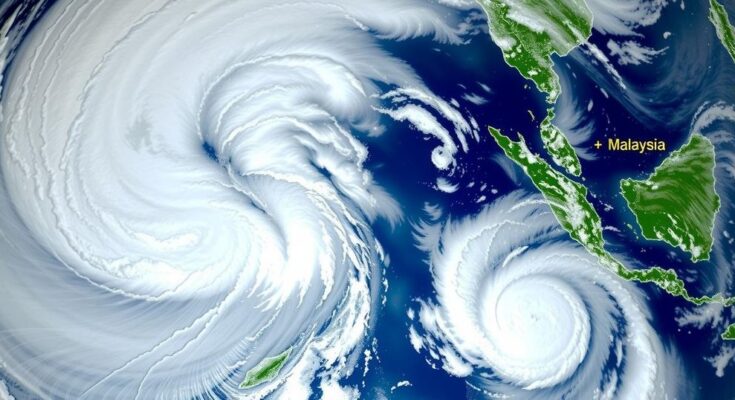Storm Darragh caused extensive damage in the U.K. and Ireland, leaving many without power and leading to fatalities. Concurrently, relentless monsoon rains resulted in severe flooding in Thailand and Malaysia, causing numerous fatalities and displacing thousands. Governments are responding with aid and assistance plans while emphasizing the need for improved climate resilience and disaster preparation.
The U.K. and Ireland faced significant disruptions last weekend due to Storm Darragh, which resulted in widespread power outages affecting hundreds of thousands of homes. The storm, classified as the fourth named storm of the 2024-25 European windstorm season, exhibited powerful winds reaching 154 kilometers per hour (96 miles per hour). The local media reported that this weather event followed previous severe flooding caused by Storm Bert, leading to multiple flood warnings across regions still recovering from prior damages. Tragically, two fatalities were reported due to fallen trees.
The U.K. Met Office issued a rare red weather warning for Storm Darragh, indicative of life-threatening conditions. Transport services including flights and trains were significantly disrupted as officials and community leaders urged for improved preparations for extreme weather events. Emma Pinchbeck, chief executive of the U.K.’s independent climate advisory body, emphasized the urgent need for better planning, particularly regarding flood defenses and construction practices in vulnerable areas.
In a parallel context, Thailand and Malaysia were also struck by severe flooding attributed to monsoon rains, resulting in at least 29 fatalities in Thailand and six in Malaysia. Thousands were displaced, seeking refuge in evacuation centers as emergency services deployed rescue teams to the worst-affected southern Thai provinces. The Thai government has announced financial aid packages to assist impacted families, signaling an organized response to the crisis.
In Malaysia, the relentless monsoon rains resulted in substantial agricultural losses, with approximately 38,000 hectares of farmland damaged. The Malaysian government is contemplating assistance measures for affected farmers, who are reeling from the recent devastation of their newly planted rice paddies. The economic impact on the agricultural sector is profound, with damages estimated at nearly 1 billion ringgit ($226 million), reflecting a persistent trend tied to adverse climatic conditions.
Severe weather events, such as storms and monsoons, are increasingly impacting various regions globally. The 2024-25 European windstorm season has seen significant storms leading to widespread disruptions in the U.K. and Ireland, highlighting the vulnerability of the region’s infrastructure and communities. Additionally, monsoon rains in Southeast Asia, particularly in Thailand and Malaysia, have exacerbated flooding issues. This scenario underscores the critical need for effective climate adaptation strategies and disaster preparedness to safeguard populations and agriculture.
The recent severe weather incidents across the U.K., Ireland, Thailand, and Malaysia illustrate the escalating challenges posed by climate change and extreme weather. Both the U.K. and Ireland are urged to enhance their preparedness for future storms, while Southeast Asian nations are grappling with the immediate repercussions of flooding. The need for cohesive climate strategies and robust infrastructural investments becomes increasingly essential to address these pressing issues.
Original Source: news.mongabay.com




